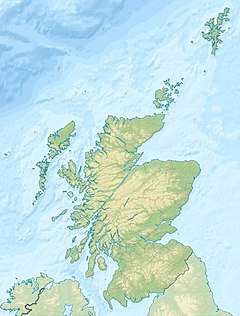St Abb's Head

The lighthouse and foghorn
|
|
|
Scotland
|
|
| Location | St. Abb's Head Berwickshire Scotland United Kingdom |
|---|---|
| Coordinates | 55°54′57.9″N 2°08′19.0″W / 55.916083°N 2.138611°WCoordinates: 55°54′57.9″N 2°08′19.0″W / 55.916083°N 2.138611°W |
| Year first constructed | 1862 |
| Automated | 1993 |
| Construction | masonry building |
| Tower shape | lantern on the roof of a 1-storey service building |
| Markings / pattern | white building, black lantern |
| Height | 9 metres (30 ft) |
| Focal height | 68 metres (223 ft) |
| Light source | mains power |
| Intensity | 3,000,000 candela |
| Range | 26 nautical miles (48 km; 30 mi) |
| Characteristic | Fl W 10s. |
| Admiralty number | A2850 |
| NGA number | 2320 |
| ARLHS number | SCO-224 |
| Managing agent |
National Trust for Scotland |
National Trust for Scotland
St Abb's Head is a rocky promontory by the village of St Abbs in Berwickshire, Scotland, and a national nature reserve administered by the National Trust of Scotland.
A signal station was established on the cliffs before 1820 and the facilities were shared by Trinity House and Her Majesty's Coastguard. The Northern Lighthouse Board recommended the building of a lighthouse at St Abb's Head after the sinking of the "Martello" on Carr Rock in 1857. The lighthouse was designed and built by the brothers David Stevenson and Thomas Stevenson and assisted navigation before and after sight of the Bell Rock and Isle of May lights disappeared from view. The light began service on 24 February 1862 and initially used oil to generate its light, it was converted to incandescent power in 1906 and to electricity in 1966 and finally automated in 1993. Before automation the lighthouse was staffed by three full-time keepers whose duties included keeping detailed weather records. The lighthouse has two km of single track tarmaced road leading to it from the main road near St Abbs village, however it is suggested by the National Trust of Scotland that it is only used by disabled visitors and there is limited parking. Visitors can walk to the Head where the lighthouse's buildings, though still in good repair, are not open to the public. A foghorn was established at the Head in 1876, being the first audible fog signal in Scotland. The original foghorn was driven by hot air engines before being replaced by oil driven ones in 1911 and then by diesel engines in December 1955. The fog signal was discontinued in 1987 although the horn is still in place and can be reached at the edge of the cliffs by a railed path from the lighthouse.
...
Wikipedia

